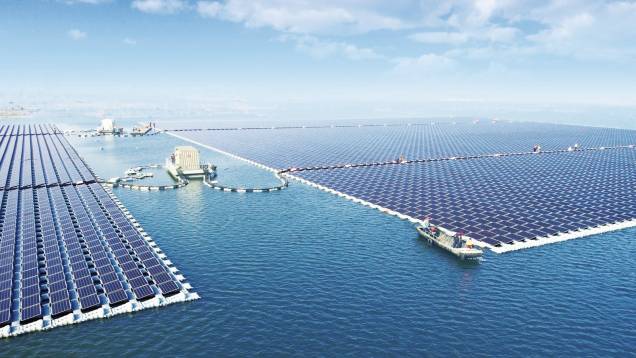
Solar power making use of what coal wrecked | Image : Sungrow
A 40MW floating solar farm, constructed on what would otherwise be a “useless” area due to the impacts of coal mining, has been connected to the mains electricity grid in Huainan, China.
According to the World Bank, Huainan has a coal mining history dating back to 1903. Ongoing coal mining in the area and elsewhere in south Anhui province has created a number of ground subsidence (lowering of land surface) sites; which effectively become unusable for usual activities.
The subsided area where the solar power project is located is flooded with heavily mineralised water ranging in depth from 4 to 10 meters.
While details regarding the type and number of solar panels used for the installation were not available, Sungrow inverters and associated equipment were implemented in the project.
Sungrow says its SG2500-MV was used; which is an integrated inverter, transformer and switchgear solution housed in a 6-metre container. The SunBox PVS-8M/16M-W PV combiner box also makes an appearance, chosen for its abilities to cope with high level of humidity and salt spray.
Floating solar farms are becoming increasingly popular around the world, particularly in countries where land resources are limited.
Aside from helping to address land use issues associated with large scale PV, there are a number of other benefits of installing solar panels over bodies of water; including increased efficiency through utilising the cooling effect of the water, reducing evaporation and inhibiting the growth of blue-green algae.
Floating Solar In Australia
Australia’s first floating solar power station was opened in Jamestown, South Australia in 2015 and construction is expected to be complete on what will become Australia’s largest floating solar energy plant (99kW), a Lismore Community Solar project, in July this year.
Hong Kong Eyes More “Floatovoltaics”
In other floating PV news, Black & Veatch has been tasked with investigating the potential for installing floating solar panels at Hong Kong’s 17 impounded reservoirs. Part of the study will involve an evaluation of two floating PV projects of 100kW capacity each at Shek Pik and Plover Cove reservoirs; with the latter still under construction.
“Thinking holistically and sustainably – how water, power and all resources are connected – is seeing a wealth of engineering innovation emerge that needs to be properly understood technically and financially,” said Alan Man, Vice President and Managing Director of Black & Veatch in Hong Kong.
“The Water Supplies Department of Hong Kong exemplifies this forward thinking through exploring how it can further secure water supply by reducing evaporation while also creating a new revenue stream by working closely with the electric grid.”
According to Research And Markets, the global floating solar panels market is expected to reach US$ 842.0 million by 2023, expanding at a compound annual growth rate of 65.1% during 2016 to 2023.

 RSS - Posts
RSS - Posts



Speak Your Mind